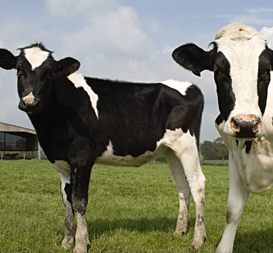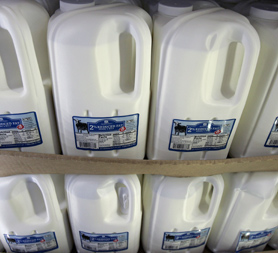‘Super-dairy’ scaled back in size
Revised plans for Britain’s controversial first “super-dairy” have been re-submitted today, with the farmers cutting in half the number of cows they intend to milk. Julian Rush has seen the new plans.

With 3,770 cows, this will still be the biggest dairy farm in Britain – and the farmers behind it admit quite openly that if it gets the go-ahead and works, they’ll submit plans to double it to 8,100 cows – as they’d originally proposed.
Devon dairy farmer Peter Willis and David Barnes, from Lancashire, withdrew their first planning application to North Kesteven District Council in Lincolnshire after objections from the Environment Agency. The site for the dairy, near the village of Nocton, is above an aquifer that provides the drinking water for the surrounding villages and the EA was concerned it could be polluted by a leak from the huge lagoons holding the millions of gallons of slurry produced by so many cows.
‘Battery cows’
The two farmers say their new plans meet those objections. But they also met furious opposition from animal welfare campaigners who raised the spectre of “battery cows” and who pointed to the appalling conditions on some huge dairy farms in the USA, where “mega-dairies” have been in operation for nearly 20 years.
Peter Willis admits there are some “very poor” farms in America, but he insists their welfare standards will be among the highest in the industry; better than many traditional small dairy farms where, for example, cows don’t have the 24 hour veterinary supervision he will provide.
Super-dairy: a cash cow or environmental hazard? Watch Julian Rush's original report.
He insists the £34 million farm would be sustainable, create 60 jobs and produce renewable energy to power 830 homes. The slurry produced by the cows would be used as fertiliser on surrounding fields, and the dairy would have a low carbon footprint as the animal feed would be grown locally.
The pair say they were “naive” at first and were taken aback by strength of public opposition and they blame campaigners with little knowledge of the realities of dairy farming.

Welfare concerns
But to satisfy welfare concerns – even though they are not considered under planning laws – they now say the cows will be allowed outside to paddocks for up to seven hours a day, when it’s dry in warmer weather. They say their sheds will be bright, well-ventilated and not over-crowded. The cows will lie on sand, which they claim has been shown to be the best and most comfortable bedding that reduces the incidence of lameness and disease like mastitis.
“These are factories, not farms.” Suzi Morris, UK Director of the World Society for the Protection of Animals
Both have been a serious problem in the past for the Holstein breed of cow they will use, which has been bred to deliver some 10,000 litres of milk every year and which is unable to survive on a diet of grass alone as a result.
Will it be enough to satisfy their opponents? It seems unlikely. Last week, Suzi Morris, the UK Director of WSPA (World Society for the Protection of Animals) accepted an invitation to visit the US super-dairy the Nocton proposal is modelled on.
She admits she saw no sign of lameness or mastitis, but she has joined other campaigners in vowing to continue the fight.
‘Factories, not farms’
“These are factories, not farms,” she said.
“And the US is waking up to the fact that pasture based systems are better for animal welfare, better for food security, better for the environment.”
But Peter Willis and David Barnes believe large dairy farms are the only way to save Britain’s rapidly declining dairy industry, which has seen 14,000 dairy farmers leave in the last decade and Britain importing millions of gallons of milk.




